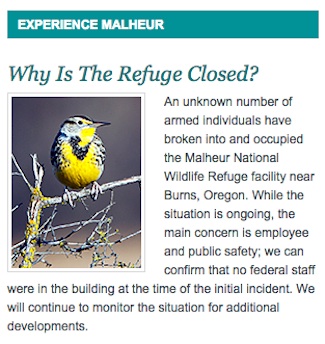 The news Sunday that a band of armed, antigovernment protesters had taken control of a federal wildlife refuge building in Harney County, OR has besieged headlines and inspired the laugh-track of social media to birth spectacularly biting insults aimed at the group, ranging from “Y'all Queda” to “Vanilla ISIS.”
The news Sunday that a band of armed, antigovernment protesters had taken control of a federal wildlife refuge building in Harney County, OR has besieged headlines and inspired the laugh-track of social media to birth spectacularly biting insults aimed at the group, ranging from “Y'all Queda” to “Vanilla ISIS.”
Behind the specter, however, beyond the easy caricature of beleaguered hillbillies waving guns at the pariah of “big gub’ment,” the curious part of me got to thinking. Assuming these men are doing what they’re doing for a reason, I couldn’t help but wonder: What do they intend to accomplish here? Why this place, and why now? And — dare I ask it — do they have a point?
 The incident has a messy backstory. Oregon ranchers Dwight Hammond and his son Steven had been in and out of the court system due to fires they’d set off on federal land dating back to 2001. (In one instance, a blaze was allegedly set to hide the fact that they were illegally hunting, an act that allegedly destroyed 140 acres.) After serving a moderate prison sentence, the federal government unexpectedly appealed the case and re-sentenced the men, under the auspices that the Hammonds’ sentences did not meet mandatory minimum requirements as dictated by a 1996 law that applies to arson committed on federal land.
The incident has a messy backstory. Oregon ranchers Dwight Hammond and his son Steven had been in and out of the court system due to fires they’d set off on federal land dating back to 2001. (In one instance, a blaze was allegedly set to hide the fact that they were illegally hunting, an act that allegedly destroyed 140 acres.) After serving a moderate prison sentence, the federal government unexpectedly appealed the case and re-sentenced the men, under the auspices that the Hammonds’ sentences did not meet mandatory minimum requirements as dictated by a 1996 law that applies to arson committed on federal land.
The Hammonds yesterday reported to serve their sentences without incident. Leave it to the sons of Cliven Bundy, however — the infamous Nevada rancher who last year kicked off a highly-publicized standoff with the Bureau of Land Management for refusing to remove his livestock from government land — to refuse to let those flames of discontent die. The Bundy family and its ragtag band of supporters have since used the event to showboat their own anti-federal agenda, first holding a rally over the weekend in Burns, OR in support of the ranchers, before later breaking into and occupying the Malheur Wildlife Refuge, effectively provoking a standoff with the federal government in the process.
The Hammonds, who have no connection with the Bundy clan, have denounced any involvement with the Oregon militia or its agenda. And residents of Harney County don’t seem particularly thrilled regarding the prospect of a revolution against government tyranny occurring in their backyards. Most want the men gone, and local schools have been shuttered, citing the possibility of violence.
With their seditious talking points, violent rhetoric and anti-government fervor, it might be easy to despise these buffoons. Easier still is our ability to make fun of them: the notion of a militia so brave they managed to breach a vacant bird sanctuary on a Sunday evening, or the surplus of armchair frontiersmen in this country whose lifelong, unrequited hero fixation has convinced them that they can overthrow a government with a $600 billion military budget, is comedy that practically writes itself.
What's far more intellectually challenging is the exercise of building an empathic bridge to these individuals, of taking a walk in their tactical boots for the sake of understanding why they feel the way they do, and why they’re going about accomplishing their objectives in such an extreme manner.
The Bundy clan, which has repeatedly asked sympathetic Americans to convene on the occupied site and lend arms to its cause, has proven itself very effective in the last year of getting the media’s attention. What they’re not so good at is crystalizing their message and elucidating to the public why their plight matters. What they need, in effect, is a crack PR man — or at least someone who understands nouns and verbs.
Here are the two themes I’d focus on if I was head of the Oregon militia’s communications team.
"Our gripes are legitimate"
In the court of public opinion, the Bundy clan’s biggest reputational challenge — aside from the guns, the idiotic rhetoric and the fact that they broke into a federal building — is the notion that the current standoff reveals a message without a cause. The Hammonds’ plight, after all, wasn’t the Bundy’s to begin with.
De facto militia spokesperson Ammon Bundy on Monday stumbled through a press conference, outlining the group's core philosophy before announcing a new name for the organization, Citizens for Constitutional Freedom. Bundy did one thing right in his ramshackle statement yesterday — and he didn’t do this nearly enough — when he touched on their grievances with federal government and its alleged mishandling and mismanagement of public land, as well as its alleged routine mistreatment of ranchers.
Are Bundy’s gripes valid? I’ll admit, I’m not an authority in the matter, so I really don't know. Cursory research shows that ranchers being forced to sell their property to the federal government via the process of eminent domain is apparently common in some areas of the country. Recourse and resources available to those who have been disenfranchised by this process are apparently few. To be honest with you, as a New York City resident, this is the first I’m hearing about it.
Agree or disagree with them, the practice of educating the public to the facts, of outlining a legitimate plight and detailing how people have been affected by it, is a first step in making the public sympathetic to any cause.
"We are not terrorists"
Bundy and his followers have said repeatedly that they are occupying the refuge building with “peaceful” intentions. Well, that’s a start. Here’s the pending question: should the Oregon militia’s actions be considered acts of "terrorism?" The media seems to think so, my friends seem to think so, but I’m not 100 percent convinced.
They haven’t hurt anybody yet, so one could argue that labeling someone a “terrorist” when their only crime thus far is trespassing, at the very least, diminishes some very real acts of terrorism that have been committed recently on both American and foreign soil. San Bernardino was terrorism. Paris, terrorism. The illegal occupation of a bird sanctuary? Let’s hold the histrionics until that moniker is deserved.
Second — and perhaps more lucidly — the practice of occupying federal property, while certainly illegal, is a tactic that's been utilized countless times in recent history by many different groups outlying many different ideological tenets. These were the bricks of the Vietnam War protests. Were members of the Occupy Wall Street movement terrorists too? I don’t think so.
The Oregon militia’s reputational problems are myriad. As a group they come across as churlish, childish, militant and grossly ignorant, and if they were truly interested in overthrowing the anathema of "tyranny" as much as they say they are, they'd do well to start by standing up against any number of daily injustices committed around the country against people who don’t happen to bear the same skin color.
However, dumb rhetoric succeeding dumb rhetoric won’t yield a positive anytime soon. Perhaps what’s needed now, until this blows over — and I’m sure it will before long — is to resist trivializing someone’s grievances, at least until an attempt is made to unpack and understand them. This process can be beneficial not only in the communications milieu, but in helping us tackle some larger — and arguably, more important — questions that have been yoked out by this event, namely, why a growing number of people in this country suggest law enforcement’s reaction to a group of armed white men has been far different from how it would be if this standoff were committed by any other group.


 There’s a fine line between newsjacking and taking advantage, aka ambulance chasing. Our job as PR professionals is to tread it carefully.
There’s a fine line between newsjacking and taking advantage, aka ambulance chasing. Our job as PR professionals is to tread it carefully. PR firms need to be mindful of ways their work product may be protected by the attorney-client privilege whenever working with a client’s internal legal team or its external legal counsel.
PR firms need to be mindful of ways their work product may be protected by the attorney-client privilege whenever working with a client’s internal legal team or its external legal counsel. Manuel Rocha, former US ambassador and intenational business advisor to LLYC, plans to plead guilty to charges that he was a secret agent for Cuba.
Manuel Rocha, former US ambassador and intenational business advisor to LLYC, plans to plead guilty to charges that he was a secret agent for Cuba. CEO mentoring is an often-overlooked aspect of why CEOs are able to make good decisions, and sometimes make bad ones—all of which intersects with the role and duties of a board.
CEO mentoring is an often-overlooked aspect of why CEOs are able to make good decisions, and sometimes make bad ones—all of which intersects with the role and duties of a board.  How organizations can anticipate, prepare and respond to crises in an increasingly complex world where a convergent landscape of global challenges, threats and risks seem to arrive at an unrelenting pace.
How organizations can anticipate, prepare and respond to crises in an increasingly complex world where a convergent landscape of global challenges, threats and risks seem to arrive at an unrelenting pace.


 Have a comment? Send it to
Have a comment? Send it to 
No comments have been submitted for this story yet.